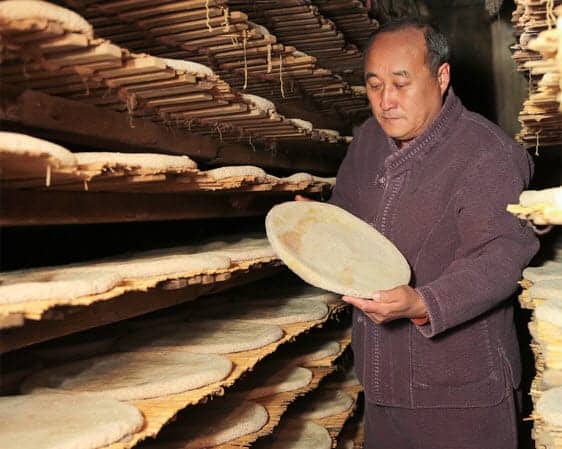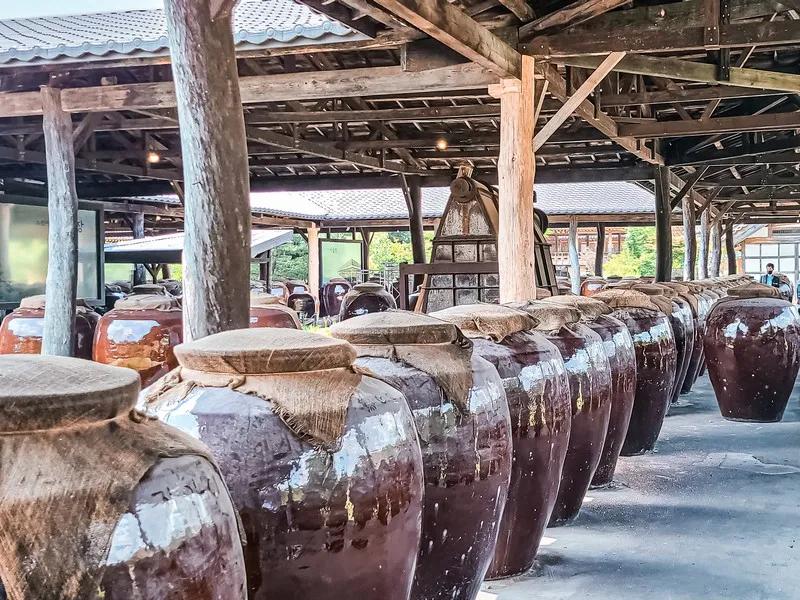Ultimate Guide to Makgeolli in 2023
Unlock the captivating world of Makgeolli, the beloved traditional Korean rice beer. Dive into the Ultimate Guide to Makgeolli and quench your curiosity. Discover the rich history, brewing secrets, and cultural significance behind this milky elixir. From its humble ingredients to its tantalizing flavors, satisfy your desire to explore Korean culinary heritage. Ready your tastebuds for an authentic adventure! Embark on a journey to craft, savor, and appreciate Makgeolli like a true connoisseur. Unveil the magic – your first sip awaits.
What is Makgeolli?
Makgeolli, also spelled as “Makoli”, is a traditional Korean alcoholic beverage. It’s a type of rice wine or rice beer that has been enjoyed in Korea for centuries. It is known for its slightly cloudy appearance, mildly sweet and tangy flavor, and relatively low alcohol content compared to other types of alcoholic drinks.

The primary ingredients used to make Makgeolli are rice, water, and a fermentation starter called nuruk. Nuruk is a mixture of various microorganisms including yeast and bacteria that play a crucial role in the fermentation process. The fermentation of the rice starches by these microorganisms results in the production of alcohol and the unique flavors characteristic of Makgeolli.
It is often enjoyed chilled and traditionally served in a bowl or a cup. It has a rich cultural significance in Korea and has been consumed at various social and celebratory occasions. In recent years, there has been a resurgence of interest in traditional Korean foods and beverages, including it, both within Korea and internationally. As a result, you might find modern variations of Makgeolli with added flavors or produced by different methods.
History Of Makgeolli
The history of Makgeolli is a tapestry woven through centuries of Korean culture. Dating back to the Goryeo Dynasty, this rice beer was enjoyed by kings and commoners alike, fostering connections and celebrations. Its popularity surged during the Joseon era, becoming a staple on every Korean table. Over time, it evolved from a homemade brew to a cherished tradition, embracing generations with its unfiltered charm. Today, the legacy lives on, with modern twists and traditional batches captivating taste buds worldwide. Explore the captivating journey of Makgeolli through time.
What Is It Made Of?
It is primarily made from the following main ingredients:



Rice: Rice is the main ingredient used in makgeolli production. Various types of rice can be used, and the choice of rice can influence the flavor and texture of the final product.
Water: Water is crucial for the fermentation process and for diluting the rice starches. It’s used to create a mixture with the rice that allows the fermentation starter to break down the starches into sugars.
Nuruk: Nuruk is a fermentation starter made from a mixture of grains such as wheat, barley, and sometimes other cereals. It contains enzymes that help convert the rice starches into sugars that yeast can ferment. Nuruk also contributes to the unique flavors of makgeolli.
Yeast: Yeast is responsible for the fermentation process, where it consumes the sugars produced by the breakdown of rice starches. The fermentation process converts sugars into alcohol and carbon dioxide, creating the characteristic taste and bubbles in makgeolli.
Optional Flavorings: While not always included, some variations of makgeolli might incorporate additional flavorings such as fruits, herbs, or other ingredients to create unique flavors.
The combination of rice, water, nuruk, and yeast forms the foundation of makgeolli production. The fermentation process transforms these ingredients into the milky, slightly sweet, and tangy beverage that makgeolli is known for.
What Does Makgeolli Taste Like?
Makgeolli is a traditional Korean rice wine with a unique taste profile. It is characterized by its delicate and complex flavors that come from the fermentation of rice, along with its slightly fizzy and cloudy appearance due to being unfiltered.

The taste of Makgeolli can vary depending on the specific recipe and brewing techniques, but generally, it can be described as follows:
- Tanginess: As you continue to sip, a delicate tanginess emerges. This tanginess balances the sweetness and provides a slightly tart, refreshing aspect to the drink.
- Earthy Undertones: The fermentation process introduces earthy notes to Makgeolli’s taste. These notes can range from mild earthiness to slightly nutty or even mushroom-like flavors.
- Slight Carbonation: Makgeolli often has a light and natural carbonation, contributing to a fizzy sensation that adds to its overall texture.
- Subtle Alcoholic Bite: While Makgeolli is not as high in alcohol content as some other alcoholic beverages, there might be a slight alcoholic bite on the finish.
- Creamy and Milky: Makgeolli’s unfiltered nature gives it a milky appearance, and this quality also translates into a creamy mouthfeel. The initial sip often feels smooth and rich on the palate.
- Subtle Sweetness: One of the standout features of Makgeolli is its gentle sweetness. This sweetness is not overly sugary but rather presents itself with a nuanced character, often reminiscent of rice sweetness.
- Rice Notes: Since Makgeolli is made from rice, its taste carries distinct rice flavors. This can manifest as a mild rice sweetness or a more pronounced rice essence, depending on the brewing process.
- Fruitiness: Some variations of Makgeolli might exhibit subtle fruitiness.
Overall, Makgeolli’s taste is a delicate balance of sweet, tangy, and slightly earthy notes, creating a refreshing and unique drinking experience. Its complexity and historical significance in Korean culture make it a sought-after beverage for those looking to explore traditional Korean flavors.
What Are the Differences Between Makgeolli and Soju?
Makgeolli and soju are both traditional Korean alcoholic beverages, but they have distinct differences in terms of ingredients, production methods, flavor profiles, and cultural significance.
- Ingredients:
Makgeolli: Primarily made from rice, water, and a fermentation starter called “nuruk,” which contains wheat, barley, and other grains. It retains a cloudy appearance due to rice solids in suspension.
Soju: Typically made from distilled grains like rice, barley, or starches like sweet potatoes. Modern versions might include other flavorings and additives. Soju is clear and transparent. - Production:
Makgeolli: Fermentation is the key process, with nuruk breaking down the rice starches into sugars for yeast fermentation. It’s unfiltered, leaving the rice sediment in the liquid.
Soju: Distillation is involved in the production of soju, which leads to a higher alcohol content compared to makgeolli. It’s then often diluted before bottling. - Alcohol Content:
Makgeolli: Usually has an alcohol content of around 6% to 8%, making it relatively low in alcohol.
Soju: Typically has a higher alcohol content, around 16% to 25% or even more, depending on the brand and variety. - Flavor Profile:
Makgeolli: Offers a slightly sweet, tangy, and sometimes fruity flavor due to the fermentation of rice and other grains.
Soju: Tends to have a cleaner and more neutral taste due to the distillation process. Flavored sojus might have added sweetness or fruitiness. - Cultural Significance:
Makgeolli: Holds a strong cultural and historical significance in Korea. It’s often associated with traditional settings, gatherings, and local food.
Soju: Also deeply ingrained in Korean culture, soju is often seen as a more versatile and widely consumed beverage in various social contexts. - Serving:
Makgeolli: Traditionally served in bowls or cups and can be enjoyed chilled or at room temperature. It’s often paired with Korean dishes.
Soju: Typically served in shot glasses and can be consumed straight, on the rocks, or as a base for cocktails.

In summary, while both makgeolli and soju are Korean alcoholic beverages, they differ in terms of ingredients, production methods, alcohol content, flavor profiles, and cultural roles. Makgeolli is a fermented rice beer with a lower alcohol content and unique flavors, while soju is a distilled spirit with a higher alcohol content and a more neutral taste.
Can You Make Makgeolli at Home?
Yes, you can make makgeolli at home, although the process requires some specific ingredients, equipment, and patience. Here’s a basic overview of how you can make makgeolli at home:
Ingredients:
- Short-grain rice
- Water
- Nuruk (fermentation starter)
- Yeast (optional, but can help with fermentation)
- Sugar (optional, for adjusting sweetness)
Equipment:
- Large pot
- Rice cooker or steamer
- Fermentation container (ceramic or glass)
- Cheesecloth or cloth for covering the container
- Rubber bands or string to secure the cloth
- Mixing utensils
Prepare Rice
Rinse the rice thoroughly and cook it.
Traditionally,
it’s often steamed, but you can also use a rice cooker.
Let the rice cool to room temperature.

Make Rice Paste
Transfer the cooled rice to a large pot and mash it to create a paste-like consistency. Gradually add water while stirring to achieve a slurry. The ratio of rice to water can vary.

Add Nuruk
Mix in the nuruk thoroughly. The amount of nuruk can vary based on the instructions on the package and the desired fermentation time. Generally, around 10-20% of the rice weight is used.

Fermentation
Transfer the mixture to a fermentation container, leaving some room at the top for expansion. Place the container in a dark and cool place with a relatively constant temperature (around 20-25°C or 68-77°F).
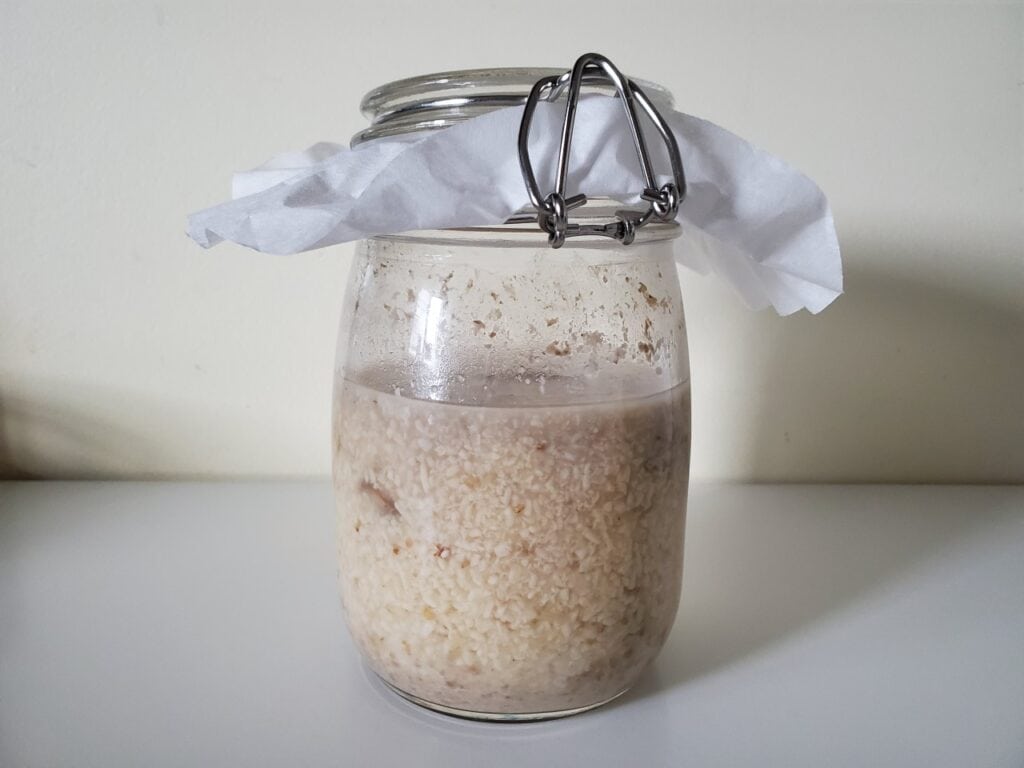
Wait
Allow the mixture to ferment for several days to a week. Stir the mixture daily to promote even fermentation. Over time, you’ll notice the liquid becoming cloudy and bubbling as fermentation progresses.

Strain
Once the fermentation is complete,
strain the liquid through a fine mesh
or cheesecloth to remove the rice solids.

Bottle and Store
Transfer the strained liquid into clean, airtight bottles. You can choose to consume it immediately, but allowing it to rest for a week or so can enhance the flavors. Keep the bottles in the refrigerator.

Serve and Enjoy
Serve it along with some of your
Korean Favorites
like, kimchi, korean pancakes.

Remember that making makgeolli requires careful sanitation to avoid contamination and spoilage. The fermentation process can vary based on factors like temperature and ingredients used. It’s a fun and rewarding DIY project, but be prepared for a bit of experimentation to achieve the desired taste and consistency.
Storing Your Makgeolli
Storing makgeolli properly is crucial to maintain its flavor, quality, and safety. Here’s how to store your homemade or store-bought makgeolli:

- Refrigeration: Makgeolli should be stored in the refrigerator to slow down the fermentation process and preserve its freshness. Cold temperatures help inhibit the growth of bacteria and yeast that could continue fermenting the beverage.
- Seal the Container: Whether your makgeolli is in a bottle, jar, or other airtight container, ensure that it’s tightly sealed to prevent air from getting in and affecting the taste and quality.
- Avoid Temperature Fluctuations: Keep the temperature of your refrigerator consistent. Avoid storing makgeolli in places where temperature fluctuations are common, such as near the door.
- Upkeep of Homemade Makgeolli: If you’ve made makgeolli at home, it might continue to ferment slightly even in the refrigerator. To prevent the buildup of pressure in the container, periodically open the lid to release any gas. Be cautious when opening, as carbonation can cause fizzing.
- Expiration Date: Store-bought makgeolli usually comes with an expiration or best-by date. Consume it before or around this date to ensure optimal taste and quality.
- Check for Spoilage: Before consuming, visually inspect the makgeolli for any signs of spoilage, such as mold, off-putting odors, or unusual color changes. If in doubt, it’s better to err on the side of caution and discard it.
- Vertical Storage: If possible, store your makgeolli bottles or containers vertically rather than horizontally. This can help prevent leakage and maintain a proper seal.
- Avoid Sunlight: Exposure to direct sunlight can negatively impact the quality of makgeolli, so store it in a cool, dark place.
- Consume in a Timely Manner: While makgeolli can be stored, its flavors may change over time. It’s best to consume it within a reasonable period to enjoy its optimal taste.
- Follow Label Instructions: If you’re consuming commercial makgeolli, follow any storage instructions provided on the label.
Best Dishes To Serve With Makgeolli
Makgeolli pairs wonderfully with a variety of Korean dishes, enhancing the dining experience with its unique flavors and refreshing qualities. Here are some popular dishes that complement the taste of makgeolli:
Bulgogi: The sweet and savory marinade of bulgogi, a grilled marinated beef dish, complements makgeolli’s profile, meat and accompanying vegetables provide a rich and balanced pairing.
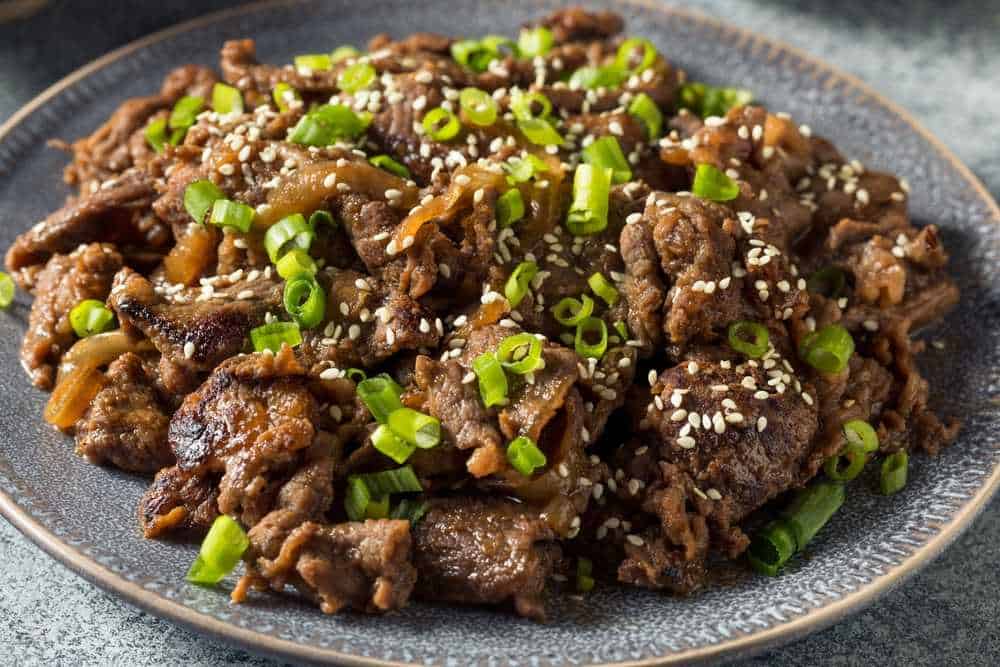
Kimbap: These Korean rice rolls filled with various ingredients,
such as vegetables, meat,
and seafood, offer a
delightful
contrast to the creamy texture of makgeolli.

Japchae: This stir-fried noodle dish features a mix of vegetables,
meat, and sweet potato
noodles. Makgeolli’s refreshing
qualities can balance the dish’s savory
and slightly sweet flavors.

Pajeon (Scallion Pancakes): The light and crisp scallion pancakes go hand in hand with makgeolli’s gentle tanginess, creating a delightful combination of flavors and textures.

Sundubu Jjigae (Soft Tofu Stew): The silky texture of soft tofu in this stew harmonizes with the refreshing qualities of makgeolli, providing a well-rounded dining experience.
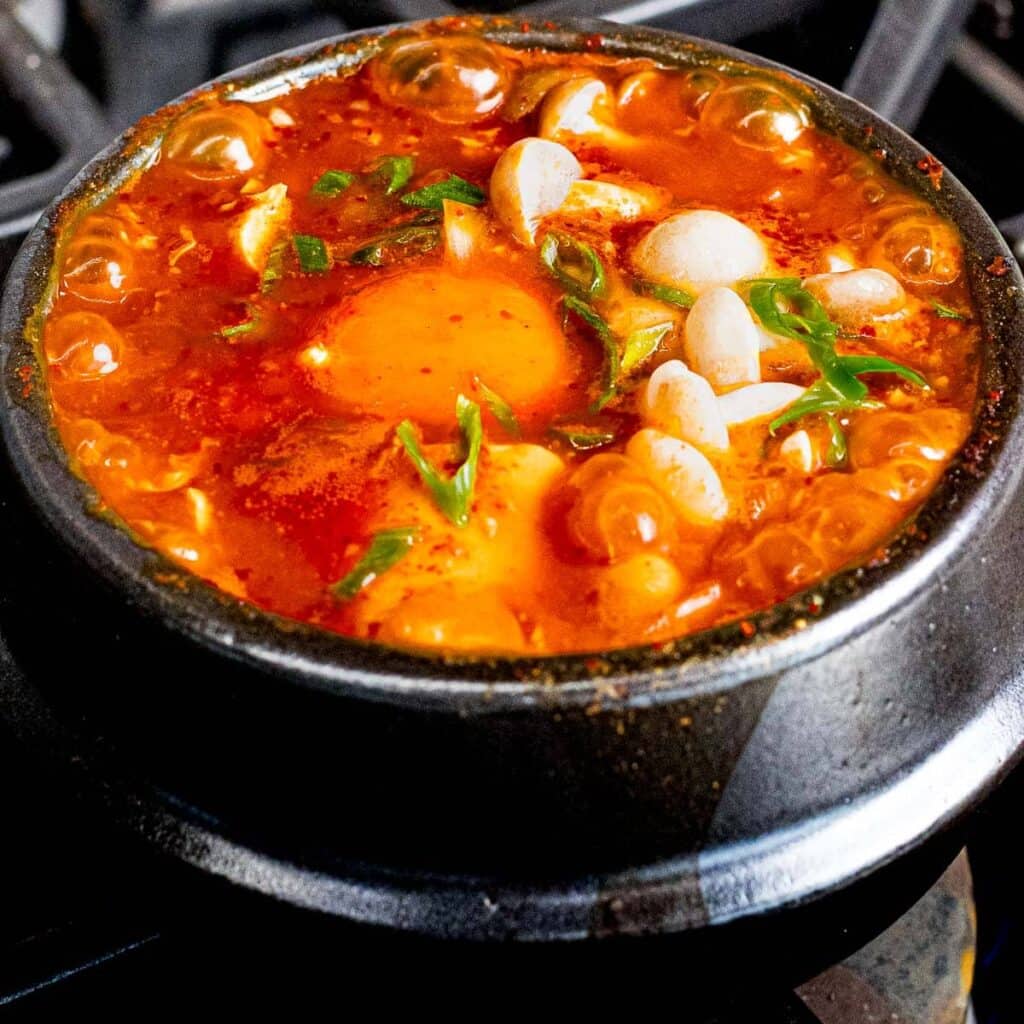
Odeng (Fish Cake Skewers): The mild flavor of odeng complements makgeolli’s profile,
making it a popular snack to enjoy with this traditional drink.

Jeon (Korean Pancakes): Makgeolli’s slightly sweet and tangy profile contrasts beautifully with the savory and crispy texture of various jeon, such as kimchi jeon (kimchi pancakes) or haemul pajeon (seafood and scallion pancakes).

Tteokbokki: The chewy rice
cakes in tteokbokki balance
the flavors
of makgeolli, and the
spiciness of the sauce
creates an interesting interplay with the drink’s
natural sweetness.

Jjigae (Korean Stews): Makgeolli can mellow the heat and
intensity of Korean stews like kimchi jjigae or doenjang jjigae.
The slight effervescence
can cleanse the palate
between spoonfuls.

Remember that personal preferences play a role in pairing food and drink. The goal is to find combinations that enhance each other’s flavors and create a harmonious dining experience. Enjoy exploring the world of Korean cuisine and makgeolli!
What are the Health Benefits of Makgeolli?
Makgeolli, like many fermented foods and beverages, is often associated with potential health benefits due to its fermentation process and probiotic content. However, it’s important to note that while makgeolli can offer some potential advantages, moderation is key, and individual responses can vary. Here are some potential health benefits of makgeolli:
- Probiotics: Makgeolli is a fermented beverage, and fermentation introduces beneficial microorganisms like bacteria and yeast into the drink. These probiotics can have positive effects on gut health by promoting a balanced gut microbiome, which is linked to improved digestion and immune function.
- Rich in Nutrients: Makgeolli retains some of the nutrients from the rice used in its production. It can provide B vitamins, including B1 (thiamine) and B2 (riboflavin), as well as other nutrients like amino acids.
- Antioxidants: The fermentation process can generate antioxidants in makgeolli, which help combat harmful free radicals in the body. Antioxidants play a role in protecting cells from oxidative stress and reducing the risk of chronic diseases.
- Digestive Health: Probiotics in makgeolli may contribute to improved digestion and absorption of nutrients. They can also help alleviate symptoms of gastrointestinal issues like bloating and gas.
- Potential Cardiovascular Benefits: Some research suggests that moderate alcohol consumption, including beverages like makgeolli, may be associated with a reduced risk of cardiovascular diseases when consumed as part of a balanced diet and lifestyle.
- Cultural and Social Benefits: Beyond its potential physiological effects, makgeolli has cultural significance and can be enjoyed in social settings. Positive social interactions and cultural traditions can contribute to overall well-being.

However, it’s important to keep in mind that makgeolli is an alcoholic beverage, and excessive consumption can have negative health effects, including:
- Alcohol-related Risks: Excessive alcohol consumption can lead to impaired judgment, motor skills, and increased risk of accidents and injuries.
- Caloric Content: Makgeolli, like other alcoholic beverages, contains calories from both the alcohol itself and any added sugars. Overconsumption can contribute to weight gain.
If you’re considering incorporating makgeolli into your diet for its potential health benefits, it’s crucial to do so in moderation and as part of a balanced lifestyle. Consult with a healthcare professional if you have specific health concerns or conditions before making any significant dietary changes.
Is It Safe to Drink it Every Day?
While moderate consumption of makgeolli might not pose significant health risks for some individuals, it’s important to approach daily consumption with caution. The safety of drinking makgeolli every day depends on several factors, including your individual health, tolerance to alcohol, and overall lifestyle.

Here are some considerations to keep in mind:
- Alcohol Content: Makgeolli, although lower in alcohol content compared to many other alcoholic beverages, still contains alcohol. Drinking alcohol daily can lead to issues like addiction, liver damage, and negative impacts on overall health.
- Caloric Intake: Makgeolli contains calories from both alcohol and any added sugars. Regular consumption can contribute to excess calorie intake and potential weight gain.
- Health Conditions: If you have any underlying health conditions, such as liver disease, digestive issues, or certain medications, consuming alcohol daily could exacerbate these conditions.
- Individual Tolerance: People have varying tolerances to alcohol. Drinking daily might lead to increased tolerance and possibly higher consumption over time, which can have health implications.
- Social and Emotional Well-being: Consider the role of alcohol in your social life and emotional well-being. Relying on alcohol daily to cope with stress or emotions can lead to unhealthy habits.
- Cultural Context: While makgeolli has cultural significance, it’s important to consider how daily consumption fits within your cultural context and values.
If you’re considering consuming makgeolli daily, it’s advisable to:
- Monitor Your Intake: Be mindful of how much you’re drinking each day and how it’s affecting your overall health and well-being.
- Consult a Healthcare Professional: If you have any underlying health conditions or concerns, it’s best to consult a healthcare professional before making a decision about daily alcohol consumption.
- Practice Moderation: If you choose to enjoy makgeolli, do so in moderation. Consider having alcohol-free days to give your body a break.
Ultimately, the key is moderation and balance. If you have any doubts or questions about daily alcohol consumption and its impact on your health, it’s always a good idea to seek guidance from a healthcare provider.
Key Considerations For Successfully Understanding Makgeolli
- Discovering the Essence: Understanding makgeolli goes beyond its ingredients and process. It’s an embodiment of Korean culture, deeply rooted in history and tradition. Its cloudy appearance and delicate flavors hold stories of ancient celebrations and modern gatherings, revealing a taste of Korea’s rich heritage.
- Culinary Adventure: Makgeolli isn’t just a drink; it’s an invitation to explore Korean cuisine. From savory pancakes to hearty stews, finding the right pairings can transform a meal into a holistic experience. Embrace the harmony of flavors as makgeolli elevates the essence of each dish.
- Moderation and Appreciation: While makgeolli offers potential health benefits, remember that moderation is key. Sip and savor its unique qualities, enjoying the journey it takes you on. Take time to appreciate the craftsmanship, cultural depth, and the moments it helps create – a balance that embodies the true spirit of makgeolli.
Wrapping Up
Exploring the world of makgeolli is an invitation to immerse yourself in the flavors, history, and culture of Korea. From its humble beginnings to its cherished place on modern tables, makgeolli offers a unique glimpse into a centuries-old tradition that continues to captivate palates worldwide.
As you embark on your makgeolli adventure, remember that each sip holds more than just a taste. It’s a connection to generations past and present, a shared experience that brings people together. Whether you’re enjoying it with a feast of Korean delights or simply indulging in its complexities, makgeolli is a journey that speaks to the heart of Korean culture.
As your guide, I’m here to offer insights, tips, and the knowledge to help you make the most of your makgeolli exploration. From understanding its history to perfecting pairings, I’m your virtual companion on this flavorful journey. So, let’s raise a glass and dive into the world of makgeolli together – a journey you won’t want to miss. Cheers! 🍻
Jl.Surjan
Disclosure: Our blog contains affiliate links to products. We may receive a commission for purchases made through these links. However, this does not impact our reviews and comparisons. We try our best to keep things fair and balanced, in order to help you make the best choice for you.

